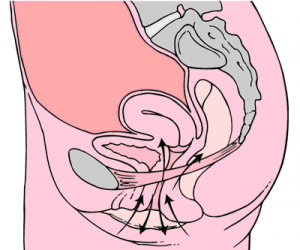Kegel's Exercise : Females: Difference between revisions
mNo edit summary |
Evan Thomas (talk | contribs) mNo edit summary |
||
| Line 2: | Line 2: | ||
'''Original Editor '''- [[User:Venus Pagare|Venus Pagare]] | '''Original Editor '''- [[User:Venus Pagare|Venus Pagare]] | ||
'''Top Contributors''' - {{Special:Contributors/{{FULLPAGENAME}}}} | '''Top Contributors''' - {{Special:Contributors/{{FULLPAGENAME}}}} | ||
</div> | </div> | ||
== Introduction == | == Introduction == | ||
Kegel's exercises are pelvic floor exercises, called after Dr. Arnold Kegel <ref name="p2">Kegel A. Stress Incontinence and Genital Relaxation: A non-surgical Method of Increasing the Tone of Sphincters and Supporting Structures. CIBA Symposium, 1952, p. 35.</ref> | Kegel's exercises are pelvic floor exercises, called after Dr. Arnold Kegel <ref name="p2">Kegel A. Stress Incontinence and Genital Relaxation: A non-surgical Method of Increasing the Tone of Sphincters and Supporting Structures. CIBA Symposium, 1952, p. 35.</ref> who developed them to strengthen the pelvic floor muscles. Dr. Kegel originally proposed his exercises as an alternative to needless and ineffective surgery, which he perceived in his own practice and those of his colleagues. He correctly anticipated several contemporary medical trends, including: | ||
#cost containment | |||
#the self-help movement | |||
#women's rights | |||
#the value of isometric exercise | |||
#biofeedback technology<br> | |||
== Kegel's Three Steps == | |||
== Kegel's Three Steps | |||
Traditionally, Kegel stated that there were three steps to his method: <ref name="site">http://www.betterkegelexercises.com/kegel_bastardization.htm</ref>. | |||
*"The first step is external observation, with the patient in the lithotomy position. Kegel first observed the patient's ability to visibly draw up the perineal structures. | *"The first step is external observation, with the patient in the lithotomy position. Kegel first observed the patient's ability to visibly draw up the perineal structures. | ||
*"The second step is vaginal examination, performed gently with one finger." The digital exam served a double purpose: first, it enabled the physician to assess the development of the puboccocygeus muscle at various depths, and second, it enabled the physician to verify that the patient was able to identify the correct muscle and contract it. Thus identification of the muscle, and not its exercise, was the purpose of Kegel's digital exam. | *"The second step is vaginal examination, performed gently with one finger." The digital exam served a double purpose: first, it enabled the physician to assess the development of the puboccocygeus muscle at various depths, and second, it enabled the physician to verify that the patient was able to identify the correct muscle and contract it. Thus identification of the muscle, and not its exercise, was the purpose of Kegel's digital exam. | ||
| Line 25: | Line 23: | ||
[[Image:11111.png|center|300x300px|Kegel's Exercise Diagram]] | [[Image:11111.png|center|300x300px|Kegel's Exercise Diagram]] | ||
===== Three steps to an effective Kegel | ===== Three steps to an effective Kegel: ===== | ||
*Learn to tighten the muscles around the vaginal/anal area | *Learn to tighten the muscles around the vaginal/anal area | ||
*Contract the vaginal and rectal muscles. | *Contract the vaginal and rectal muscles. Note that when you perform steps 1 and 2 correctly, you should also feel the muscles around the anus tighten slightly. This is normal, but do not consciously try to tighten those muscles. | ||
*In a quiet, relaxed setting with no distractions, practice your Kegels and determine how long you can hold your contraction and how many you can do before becoming fatigued. | *In a quiet, relaxed setting with no distractions, practice your Kegels and determine how long you can hold your contraction and how many you can do before becoming fatigued. Do not do more than 5-10 reps at time with a 3-5 second hold. | ||
== Amount of Exercise Prescribed == | == Amount of Exercise Prescribed == | ||
*Kegel routinely prescribed a therapeutic regimen of a full hour a day of practice with his Perineometer device in the vagina. | *Kegel routinely prescribed a therapeutic regimen of a full hour a day of practice with his Perineometer device in the vagina. | ||
* | *Nowhere does he mention the duration of a single contraction, but he states that "twenty minutes, three times a day, or for a total of 300 contractions daily". | ||
*Sixty minutes times 60 seconds equals 3600 seconds, divided by 300 repetitions allows for 12 second cycles. | *Sixty minutes times 60 seconds equals 3600 seconds, divided by 300 repetitions allows for 12 second cycles. | ||
*In his drawings of "pressure over time" he sketches symmetrical sine waves, and he remarks that in the final, healthy stage contractions become "prolonged", so by simple arithmetic he envisioned six-second contractions. | *In his drawings of "pressure over time" he sketches symmetrical sine waves, and he remarks that in the final, healthy stage contractions become "prolonged", so by simple arithmetic he envisioned six-second contractions. <ref name="site" /><br> | ||
== Benefits == | == Benefits == | ||
*Kegel exercises are designed to strengthen the pelvic floor muscles which support the | *Kegel exercises are designed to strengthen the pelvic floor muscles which support the bladder and bowel openings | ||
*Strengthening the muscles of the pelvic floor can aid in preventing urinary and | *Strengthening the muscles of the pelvic floor can aid in preventing urinary and fecal incontinence | ||
*Enhanced sexual function | *Enhanced sexual function | ||
*conditioned muscles to make childbirth easier | *conditioned muscles to make childbirth easier | ||
*decrease and/or prevent [[Pelvic_Organ_Prolapse|prolapse of pelvic organs]] and | *decrease and/or prevent [[Pelvic_Organ_Prolapse|prolapse of pelvic organs]] and | ||
*improve the ability of | *improve the ability of defecation<br> | ||
== Presentations == | == Presentations == | ||
| Line 68: | Line 66: | ||
<references /> | <references /> | ||
[[Category:Womens_Health]][[Category: | [[Category:Womens_Health]] [[Category:Pelvic Health]] [[Category:Exercise_Therapy]] | ||
Revision as of 08:11, 28 August 2017
Original Editor - Venus Pagare
Top Contributors - Venus Pagare, Nomvula Dlamini, Abbey Wright, Admin, Laura Ritchie, Kim Jackson, Lauren Kwant, Evan Thomas, WikiSysop, Vidya Acharya and Nicole Hills
Introduction[edit | edit source]
Kegel's exercises are pelvic floor exercises, called after Dr. Arnold Kegel [1] who developed them to strengthen the pelvic floor muscles. Dr. Kegel originally proposed his exercises as an alternative to needless and ineffective surgery, which he perceived in his own practice and those of his colleagues. He correctly anticipated several contemporary medical trends, including:
- cost containment
- the self-help movement
- women's rights
- the value of isometric exercise
- biofeedback technology
Kegel's Three Steps[edit | edit source]
Traditionally, Kegel stated that there were three steps to his method: [2].
- "The first step is external observation, with the patient in the lithotomy position. Kegel first observed the patient's ability to visibly draw up the perineal structures.
- "The second step is vaginal examination, performed gently with one finger." The digital exam served a double purpose: first, it enabled the physician to assess the development of the puboccocygeus muscle at various depths, and second, it enabled the physician to verify that the patient was able to identify the correct muscle and contract it. Thus identification of the muscle, and not its exercise, was the purpose of Kegel's digital exam.
- The third stage follows quickly: "after [only] 5 to 10 correct contractions the Perineometer is inserted, and both physician and patient watch the manometer to note the results of her efforts" (emphasis added). In several articles, the insertion of the Perineometer biofeedback device marks the beginning of the third and primary step in Dr. Kegel's exercise program.
- It is important to observe that Kegel defined his exercises "operationally", rather than "formally". That is, rather than specify "how to do the exercises", he specified what would be measured if they were done correctly with his device in place. He invented and used the world's first biofeedback instrument, the perineometer, to objectively assess pelvic muscle strength, both in the office, and in daily at-home use by the patient
Three steps to an effective Kegel:[edit | edit source]
- Learn to tighten the muscles around the vaginal/anal area
- Contract the vaginal and rectal muscles. Note that when you perform steps 1 and 2 correctly, you should also feel the muscles around the anus tighten slightly. This is normal, but do not consciously try to tighten those muscles.
- In a quiet, relaxed setting with no distractions, practice your Kegels and determine how long you can hold your contraction and how many you can do before becoming fatigued. Do not do more than 5-10 reps at time with a 3-5 second hold.
Amount of Exercise Prescribed[edit | edit source]
- Kegel routinely prescribed a therapeutic regimen of a full hour a day of practice with his Perineometer device in the vagina.
- Nowhere does he mention the duration of a single contraction, but he states that "twenty minutes, three times a day, or for a total of 300 contractions daily".
- Sixty minutes times 60 seconds equals 3600 seconds, divided by 300 repetitions allows for 12 second cycles.
- In his drawings of "pressure over time" he sketches symmetrical sine waves, and he remarks that in the final, healthy stage contractions become "prolonged", so by simple arithmetic he envisioned six-second contractions. [2]
Benefits[edit | edit source]
- Kegel exercises are designed to strengthen the pelvic floor muscles which support the bladder and bowel openings
- Strengthening the muscles of the pelvic floor can aid in preventing urinary and fecal incontinence
- Enhanced sexual function
- conditioned muscles to make childbirth easier
- decrease and/or prevent prolapse of pelvic organs and
- improve the ability of defecation
Presentations[edit | edit source]
 |
Pelvic Physiotherapy - to Kegel or Not?
This presentation was created by Carolyn Vandyken, a physiotherapist who specializes in the treatment of male and female pelvic dysfunction. She also provides education and mentorship to physiotherapists who are similarly interested in treating these dysfunctions. In the presentation, Carolyn reviews pelvic anatomy, the history of Kegel exercises and what the evidence tells us about when Kegels are and aren't appropriate for our patients. |
References[edit | edit source]
- ↑ Kegel A. Stress Incontinence and Genital Relaxation: A non-surgical Method of Increasing the Tone of Sphincters and Supporting Structures. CIBA Symposium, 1952, p. 35.
- ↑ 2.0 2.1 http://www.betterkegelexercises.com/kegel_bastardization.htm







